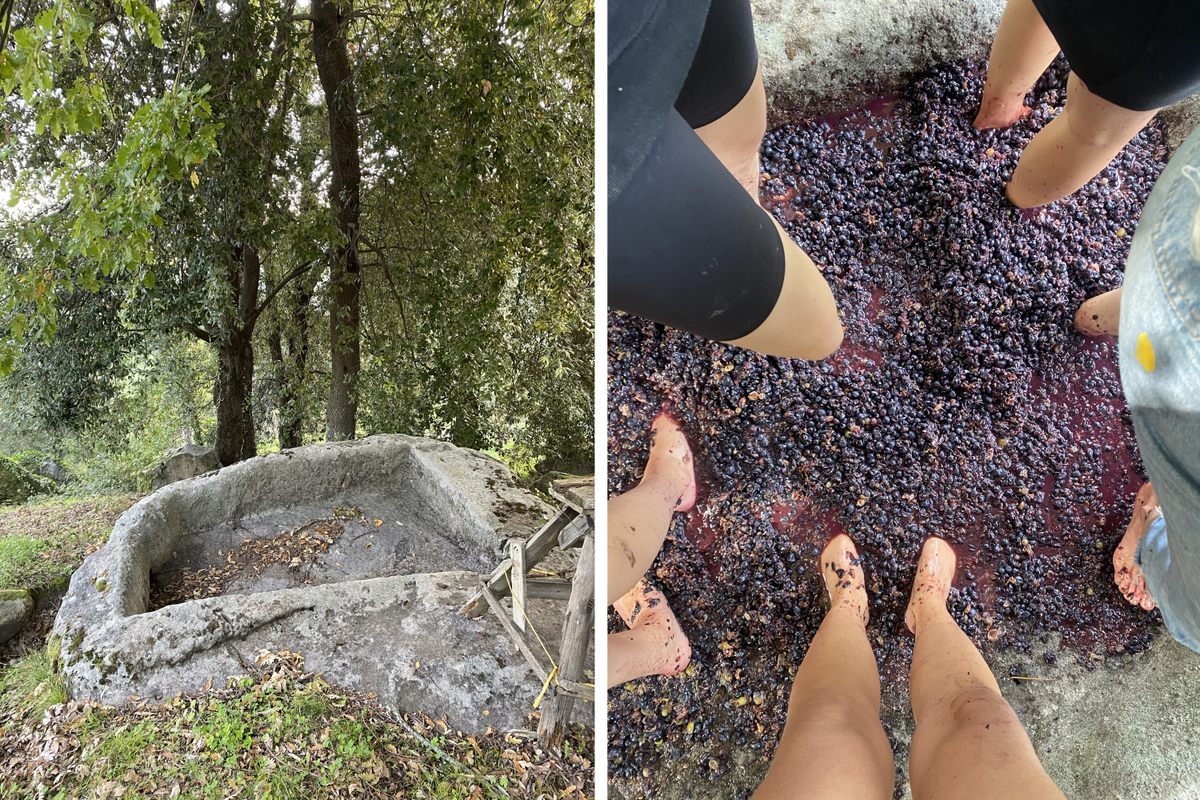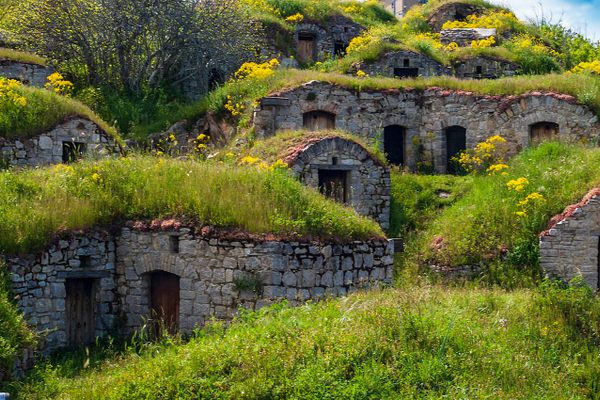

Were These Giant Carved Stones Used to Make Ancient Italian Wine?
Rocky artifacts may offer insight into an Etruscan industry.
One crisp winter day in 2004, Uran Pelushi was walking along the banks of the Vivo, a creek in the Seggiano Valley in southern Tuscany. Unexpectedly, he noticed an object jutting from the leaf-covered earth.
At first, it resembled one of the many charcoal-colored tuff rocks that cover the ground in the area. But as he cleared away the weeds around it, a more complex structure started to emerge. What he uncovered was a mossy stone that had been carved to create two basins, each about two feet across and connected by a small channel. Immediately, Pelushi knew he had to make a call. “I think I have found one of those stones,” he told his boss, British winemaker Charlotte Horton, who had asked him to report sightings of any unusual rocks.
Horton first learned about the stones in 2002 on a walk with friend and local farmer Moreno Filoni. “I was immediately curious about them and asked Moreno what they were,” she recalls. Filoni, like many locals, had some vague notions about the basins, which locals call pestarole. It was commonly thought the Etruscans, the people who inhabited Tuscany and Latium before the Romans, probably excavated volcanic stones for agricultural purposes. “Many people thought they were used to water animals,” Horton says. “But I wasn’t convinced.”
All of the stones she had encountered were right by rivers, something that challenged the watering option—animals did not need man-made basins to drink. The stones were also tilted, suggesting that they were used to process something in the upper basin that would flow to the lower basin. “As a winemaker, my instinct was that they were used to make wine,” Horton says.
Two years later, she turned her instinct into practice. Together with a group of volunteers, she transported grapes from her vineyards to the nearby “winemaking stones,” as she now calls them. A video from the time shows a group of enthusiastic harvesters stomping their bare feet on the plum-colored grapes, placed in the upper basin, while others collected the must, a combination of juice and pulp, from the lower basin with buckets.
This simple, intuitive technique offers insight into how the Etruscans may have made their wine. Etruscans are widely believed to have taught winemaking to the Romans and the people living in modern-day France, making their practices the foundations of both Italian and French wine. Winemakers around the world are thus fascinated in the possibility of understanding more about their techniques.
But as Horton soon found out, finding more about the pestarole is not an easy feat. ”There is very limited research on these structures,” says Cinzia Loi, professor of archeology at the University of Sassari, and the author of the only academic study on the stones. Loi looked at 145 wine stones mostly in the areas of Guilcer and Barigadu, in rural Sardinia. “It’s very hard to find evidence that can prove how they were used,” she says.
Horton herself spent years gathering information on the stones and found very little that could help her understand more about when they were made and when they were used. Undeterred, she decided to take things in her own hands. She now runs an exploratory archaeobotanical project at Potentino, her 10-acre farm estate at the foothills of Mount Amiata.

When thinking of southern Tuscany, most people can conjure up an image of rolling hills and wineries dotted by medieval towns. However, the valley of Mount Amiata is a collection of chestnut and beech forests, thermal water springs, and volcanic boulders. “Mount Amiata used to be an active volcano,” says Guido Lavorini, a geologist working for the regional government. “This explains why this area looks morphologically different from nearby valleys.” The volcanic past is still evident today, with tall boulders towering over the valley in places like Vivo d’Orcia, Piancastagnaio, and Dante’s Rock. The volcano, Lavorini adds, developed out of a pre-existing sea that once covered this area between the Cretaceous and the Pliocene eras.
Horton’s winery is located at the foothills of Mount Amiata in an area known to locals as Conca d’Oro, or “the golden bowl,” due to the high fertility of the land. Here, she runs a winery, a bed and breakfast, and an education center, all hosted within the once-abandoned 14th-century estate that she renovated in the late 1990s. “I keep discovering new things that make this place so unique,” she says. Without even knowing, Horton’s family had bought land in what she now describes “a winemaker’s dream place.”
On top of the great fertility of the volcanic soil, there is an ideal micro-climate for growing grapes, thanks to the cool air that flows from Mount Amiata. Recently, Horton has learned that her land is also full of fossils, a legacy of the time when the whole area was a warm and shallow sea. “Minerals from ancient sediments change to clay minerals,” says Terri Hood, a professor of geology who studied the soil of Horton’s estate. “In the process, they release macro and micronutrients.”
These clay minerals help retain water and dissolve nutrients right in the root zone of plants, acting as fertilizers. “I think this is why the Etruscans were here in the first place,” Horton says. “They were great observers of nature, and knew they had found the perfect place to grow food.”
The Etruscans are known for their elaborate cult of the dead—they built entire underground cities dedicated to the deceased—and for their flourishing maritime trade with nearby Mediterranean civilizations. They were also known as grape farmers. Evidence of viniculture in the region has been found dating back to 1000 B.C., says Andrea Ciacci, a professor of archeology at the University of Siena, adding that, back then, humans probably tended wild grapes.
Archeologists have found much evidence that wine was part of Etruscan life, from clay amphorae from shipwrecks to depictions of wine-fueled banquets. “Wine appears to have been a key aspect of social life during the 8th century [B.C.],” says Professor Anthony Tuck, chair of the Classics department at the University of Massachusetts Amherst. Written records also cite the Etruscans as wine exporters. In his first century B.C. Biblioteca Historica, ancient Greek historian Diodorus Siculus mentions that the Etruscans were exporting wine to the Gauls, a people that lived in what is now France, for an “extortionary amount of money.”
Oral traditions also seem to suggest a link between current winemaking traditions and the Etruscans. “In parts of Tuscany today, people ask for the intervention of Faflan to help with the harvest,” Tuck says. “Faflan sound a lot like Fuflun, the Etruscan god of wine from which the Roman God Bacchus was developed.”
But when it comes to actually proving that these ancient people were winemakers, things get more complicated.“The challenge is that, even when we have paleobotanical evidence of grapes dating to Etruscan times, we don’t have evidence that grape was used for wine,” Tuck says.
This, Tuck explains, is largely because Etruscan winemaking would not leave behind archeological evidence. “My guess is that they mostly processed grapes in wicker or woven baskets,” he says, adding that images depicting this technique have been found. But grapes and wicker tend to dissolve over thousands of years.
Archeologists know that the Etruscans could grow grapes and they know that wine was a central part of Etruscan culture. But what’s missing is definite archeological proof that they were winemakers. Horton’s wine stones may be the missing link.
In 2021, Horton launched the Potentino Exploration Project, a multi-disciplinary research effort aimed at reconstructing the history and prehistory of the Seggiano Valley and the Monte Amiata region. Horton asked academics in disciplines such as archeology, ethnobotany, and biodiversity to do fieldwork at her estate in southern Tuscany. The first workshops kicked off last summer. In June, Greg Warden, a Professor of Archeology at Franklin University Switzerland, led a team of students in archeological workshops around the estate.
First, Warden attempted to date the wine stones. “It’s not hard to date the stone itself, geologically,” Warden explains. “But it’s almost impossible to date when the stone was carved.”
In cases like this, archeologists look for contextual evidence, which in many cases consists of items found near an artifact that indicate when it had been used. “We were looking for ceramics especially,” Wardens says, “but also any material evidence connected to the use of the vats.”
Warden and a team of 14 students excavated three areas in different parts of the estate. Nothing of note emerged, but he plans to come back next summer to keep looking for anything that may link these stones to Etruscan winemaking.

Carved stones like the ones found in Tuscany exist all around the Mediterranean and Middle East. They have been spotted in Italy, France, Spain, Greece, Malta, Georgia, and Iraq. In Italy alone, there are thousands, spread from Liguria in the north, all the way to the islands of Sicily and Sardinia. The largest cluster to date was found in Calabria, the region located in the “toe” of Italy. Here, more than 1,000 winemaking stones lie on the coast near Locri, on the Ionian sea.
While Warden never found contextual evidence around Horton’s estate, researcher Loi, the author of the only academic study on wine stones, has discovered ceramic fragments of amphorae scattered around some of the stones that she studied in Sardinia. But in order to better understand how the stones were used, she turned to experimental archeology, a field of study dedicated to testing archaeological hypotheses. “We thought the stones were used either as a tool for processing natural fibers or as basins to harvest grapes,” she explains.
Together with a team of students, Loi set up two experiments based on each hypothesis. In the first one, they placed animal skin and plant fibers in the upper basin. They then added enough water to allow for fiber retting, where water is used to break down materials, making textile fibers extractable. “That did not work very well,” Loi says. “The fact that the stones are shallow and tilted does not allow water to stagnate long enough to break down the fibers.” Plus, it took a long time and a great deal of water to clean the stones after the experiment, something that would make little sense in the water-scarce Mediterranean.
In her second experiment, Loi placed grapes in the upper basin. The grapes were then stomped by foot by Loi and her team. Like Horton, Loi found that the stones seemed to be perfectly designed for the purpose. Grapes placed in the upper basin could be easily crushed thanks to friction with the underlying rock. Must easily flowed in the lower basin, due to gravity.
Based on these experiments, Loi concluded that the stones were most likely used for winemaking. “This study was just the beginning of what I hope can be a more in-depth and larger study on these artifacts,” she says.
For years, Loi has actively asked local cultural heritage institutions to support her academic interest in the stones. But most of the time, she has found little or no support. The reason for this lack of interest from institutions is due to a surprising fact: Several of these age-old stones were used to make wine in living memory, in some places up until the 1950s. “Many people in this part of Sardinia have memories of their grandparents stomping wine in these stones,” Loi says.
Horton, too, has found evidence of winemaking stones in action, from a photographic archive by 19th-century anthropologist Gerard Rolfs. “I found this photo last year,” she says, showing a black and white picture from the late 19th century depicting people using wine stones in Calabria. “It was my ah-ha moment!” Horton says, adding that she thought this image could be the “final proof” that these stones were used to make wine .
But, in a twisted logic, evidence of recent use is what makes local cultural heritage institutions uninterested in the stones. “Since we can’t prove that these stones were used in ancient times, most people think they are just unsophisticated tools from a recent, backwards past,” Loi explains.

The same issue is raised by Orlando Sculli, a retired high school professor with a passion for archeology. Sculli lives in the area of Locride, in southern Calabria. Over the last 10 years he has found and cataloged as many as 157 winemaking stones in the area. Yet, when he approached local cultural heritage institutions to ask for formal studies on the stones, he was routinely turned down. “They don’t see these as a legacy of ancient civilizations,” he explains. “They just see them as backwards agricultural tools.”
In 2014, Sculli finally found some evidence that helped change authorities’ perception of the artifacts. After looking at photos of the winemaking stones of Locride, he noticed that two of them had been carved with the Justinian cross, the symbol of Emperor Justinian who ruled the Byzantine Empire between 527 to 565. “This shows that they were in use at least as far back as 1,500 years ago,” Sculli says.
Sculli also found a description by historian Diodorus Siculus that seems to refer to the winemaking stones. In a passage from his Historiae, Diodorus mentions within the cellar of Tellia, the richest man living in what is modern-day Agrigento in Sicily, there were “300 tanks hewn out of stones, each as large as 100 amphorae.” He also adds that, near these tanks, there was a basin “as large as a thousand amphorae from which they transferred the wine in the tanks.”
When Sculli brought forward this evidence to state archeologists in 2016, they agreed to commission the first official study on winemaking stones. The findings will be submitted to a team of experts that will assess if they qualify as items of cultural interest. What Loi, Horton, and Sculli all hope is that cultural heritage institutions will eventually deem the stones as worthy of protection. “Right now there is no protection at all,” Sculli says, adding that recently, some stones in the Ferruzzano have been damaged by excavators doing public works.
The study will also provide the first official dating of these artifacts, something that will finally shed light into the timeline of their creation. It is very likely that they were first created in pre-Roman times and later adopted by the Romans and other civilizations. “Thanks to rigorous archeological examination, we will soon be able to date the stones more accurately,” Sara Bini, a state archeologist involved with the study explains. “We think some of these go back to Imperial Rome, while others are even more ancient.”

After her first experiment in 2004, Horton has refined her “Etruscan” winemaking technique. She currently produces a magenta-colored natural wine called Tumulus, Latin for “little hill,” made of Sangiovese grapes crushed by foot on wine stones. The wine is then aged for six months in stainless steel and bottled in amphora-shaped ceramic flasks. “I think this is the closest you get to making wine the way the Etruscans used to,” she says.
Next summer, the Potentino Exploration Project will resume. Warden will return to this remote corner of Tuscany to keep looking for anything that can prove that Etruscans effectively made wine using these particular stones more than 2,000 years ago. If the archeological search yields results, it may change the way we understand Etruscan winemaking.
But to Horton, Etruscan winemaking at Potentino isn’t just about the history. She sees it as part of a wider strategy to spare this unique valley from development. In recent decades, local administrators have pushed to build hotels in the area. That would mean losing a chance to study and preserve a region that has remained virtually unaffected by modernization.
“This is one of the few regions in Tuscany that hasn’t been ravaged by industrial agricultural practices that decimate species biodiversity,” says Meryl Shriver-Rice, an professor of environmental archeology at the University of Miami who is leading biodiversity research as part of Potentino Exploration Project. Next summer, Shriver-Rice and her students will look for evidence of past farming practices and the way they affected local biodiversity.
Horton’s Potentino Exploration Project ultimately hopes to prove that farming and winemaking are the best future industries for the valley, along with for continued research into the Etruscans. “What’s interesting to me is the connection between this place, these ancient traditions, and wine,” Horton says as she shows photos of eager volunteers crushing Sangiovese grapes on the winemaking stones like people likely did some 2,500 years ago. “It’s not 1970’s style construction development that this sort of place needs,” she continues. “It’s preservation, study, and innovation.”
Gastro Obscura covers the world’s most wondrous food and drink.
Sign up for our regular newsletter.























Follow us on Twitter to get the latest on the world's hidden wonders.
Like us on Facebook to get the latest on the world's hidden wonders.
Follow us on Twitter Like us on Facebook